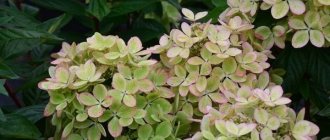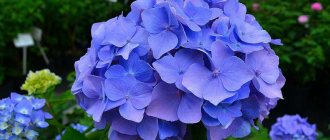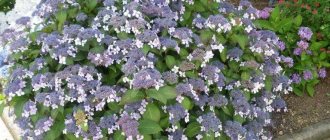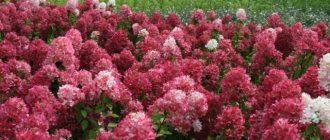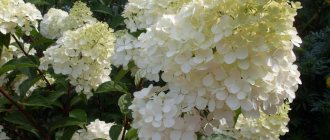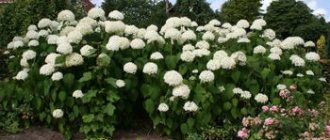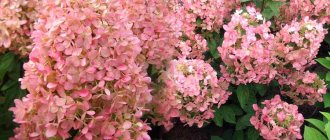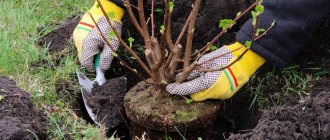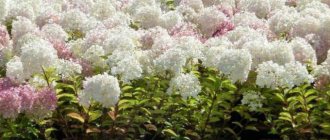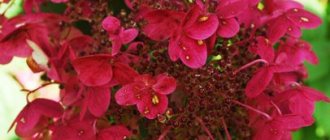Botanical description of the species
Oakleaf hydrangea (Hydrangea quercifolia) is a perennial decorative representative of the flora from the Hydrangeaceae family of the same name. The natural habitat of the species is considered to be North America; on other continents the plant is found exclusively in artificial conditions.
This ornamental shrub grows up to 2 m in height, while the crown diameter can reach 1.5–2 m. The plant consists of powerful and dense shoots, green or brown-green in color.
The name of the species was given for a reason; its main distinguishing feature is considered to be large leaves with a five-lobed structure, which in outline resemble the foliage of an oak tree . The edges of the leaves are sharp, covered with small pointed teeth. Young leaves are dotted with short but numerous white hairs. As the leaf blade grows, the pubescence disappears, remaining only on a small part.
Did you know? North America is considered to be the center of origin of all hydrangeas; here this species arose as a result of natural hybridization about 40–70 thousand years ago. The plant was brought to Europe in 1820 from Japan.
As the growing season progresses, large flower stalks are formed, up to 20 cm long. They are covered with small flowers, up to 3 cm in diameter, their color can be either white or a combination of various tones. Individual flowers form a paniculate, cone-shaped inflorescence. Hydrangea blooms from the first half of June until the beginning of September.
This species is characterized by winter hardiness; in the middle climate zone the shrub can withstand frosts down to –29°C. That is why it grows well in the Moscow region and in all regions of the Moscow region. At the same time, oakleaf hydrangea is also unpretentious, so the annual growth of young shrubs on almost any type of soil is about 30–50 cm.
Application in landscape design
Hydrangea is considered one of the most versatile ornamental crops in modern landscape design. The oakleaf species looks quite organic both as a monoculture and in group plantings.
Most often, bushes are used for landscaping the lower tier of tree-like vegetation, creating hedges or decorating areas near various garden buildings. Bushes are also successfully grown on artificial or natural slopes.
The most successful partners in planting hydrangeas are:
Check out
Hydrangea on a standard in landscape design
- lily;
- peonies;
- low varieties of roses;
- sedums;
- asters;
- lilac;
- derain;
- spirea;
- rhododendron;
- weigela;
- heather;
- cypress;
- barberry;
- Mahonia.
Popular varieties of oakleaf hydrangea
The popularity of hydrangea among gardeners is quite high, which is why today there are a huge number of so-called “oak-leaved” varieties. However, among them, only a few, distinguished by the greatest decorativeness, enjoy special love.
Harmony
The Harmony or Harmonity variety is distinguished by fairly large inflorescences of white shades, reaching a length of 30 cm. The average height of this plant is about 150 cm, the crown is quite dense and moderately spreading. The plant is characterized by increased resistance to all kinds of specific fungi and bacteria. The variety tolerates partial shade and low temperatures well.
Amethyst
Hydrangea Amethyst can be called the best plant for shady gardens; the variety grows well under the cover of tree-like vegetation, in the foreground or in the lower tier. At the same time, the bush is compact, its average height is about 70 cm, the crown width is in the range of 60–70 cm.
The inflorescences consist of individual lime-green flowers, which are gradually covered with crimson spots. Over time, the main shade changes to turquoise or green-turquoise.
Snowflake
Among all kinds of plant varieties, Snowflake can be called one of the most compact. The bush is round in shape, up to 40 cm high and no more than 35 cm in diameter. Large cone-shaped inflorescences are considered one of the distinctive features of the variety. They consist of small snow-white flowers, which appear brightly against the background of the graceful green crown of the bush.
Snow Queen
Snow Queen or Snow Queen is a fast-growing and spreading bush, up to 2 m high. The flowers have all sorts of white shades, collected in paniculate inflorescences 10 cm long. The leaves are a rich green shade, which transforms to orange as the growing season progresses. burgundy and red tones.
Burgundy
This variety is classified as a large, fast-growing shrub, with an average height of about 2 m. Burgundy is distinguished by its rather exotic leaf color. In summer, all sorts of green tones predominate, which, as the growing season progresses, by autumn they acquire shades from purple-violet to orange-red. The inflorescences consist of small white flowers, at the end of flowering they turn pink or pale pink.
Sykes Dwarf
This plant is primarily known to gardeners due to its fairly high decorative properties of both inflorescences and foliage. Sike's Dwarf forms paniculate inflorescences up to 30 cm long, consisting of small snow-white flowers. The foliage in summer and spring has a rich green color, in the fall its color becomes brighter, in all sorts of red shades.
Oakleaf hydrangea: planting options and gardening tips for care
Oakleaf hydrangea is a perennial, heat-loving deciduous shrub, reaching 1.5 to 2 m in length and 2 m in crown spread. On the powerful trunk there are decorative 3-7-lobed rough leaves, shaped like oak leaves. The shrub blooms from June to August. White flowers are collected in lush paniculate inflorescences.
Oakleaf hydrangea can be used both in single plantings and in ensembles with other flowering shrubs.
In summer, hydrangea leaves are green, but as autumn approaches, they change color to red and purple.
Oakleaf hydrangea is demanding on temperature and lighting. Prefers sunlit areas, but can also tolerate partial shade. It does not tolerate harsh winters well, so the southern and middle latitudes of Russia (zones of mixed and deciduous forests, forest-steppe) are suitable for cultivation.
The plant is very demanding on soil fertility and its composition; acidic loamy soils are ideal for planting.
Landing
Despite its unpretentiousness, hydrangea requires compliance with a specific planting procedure. Only this will enable the seedling to take root well, as well as form a large bush, and is also the main condition for the long and abundant flowering of large inflorescences.
Selecting a location
Hydrangea grows well in shade, partial shade and full sun, but it is demanding on moisture and soil composition. The bushes cannot tolerate high moisture, so they are planted on plains or hills, in open but draft-protected parts of the site.
Regarding the substrate, well-fertilized sandy loam or loamy soils with a pH in the range of 4.5–6 are best suited for planting.
Landing dates
Hydrangea planting is carried out in the spring - this is a mandatory requirement. In the case of autumn planting, young plants do not form a full-fledged root system, so after the first cold weather they can freeze out. The procedure is performed at the beginning of the season; the first half of May is best suited for this.
Soil preparation
The formation of the landing site begins approximately 2 weeks before planting the seedlings. First, the area must be cleared of remnants of weeds and debris, and then plowed well to a depth of at least 30 cm. After this, the soil must be fertilized; for this, approximately 5 kg of compost, humus or rotted manure should be added per 1 m².
If necessary, the soil should also be acidified; for this, the soil should be watered with a weak acid solution. It is prepared from 2 tbsp. l. citric acid or 100 ml of vinegar (9%) and 10 liters of water, the liquid consumption should be about 10 l/m². After this, the soil should be plowed well again.
Read more about what soil is needed for planting garden hydrangea.
Landing algorithm
The basic technique for planting young plants is similar to the same procedure for other varieties of ornamental plants.
The manipulation is based on uniform agrotechnical principles and involves the following sequential steps:
- Dig a hole in the soil measuring 50x40 cm (depth/diameter).
- Place a drainage layer of small crushed stone, gravel or broken brick about 10 cm thick at the bottom of the hole.
- Fill the planting hole one third with a mixture of equal parts of garden soil and peat, and then add 50 g of nitroammophoska.
- Plant the seedling in the soil, the root collar should go no more than 2–3 cm deep.
- Fill all the voids between the root system and the soil, and then water the plant well (5 liters of water/bush).
Diseases and pests
The crop is rarely affected by pests and diseases, but the most common fungal diseases are gray rot, mildew, and chlorosis.
Downy mildew (downy mildew) appears when treatment against the disease is carried out at the wrong time; fat yellow spots appear on the leaves, becoming more saturated in color and increasing in size over time. To get rid of downy mildew, they resort to spraying with a solution: 20 g of copper sulfate and 200 g of laundry soap are dissolved in 10 liters of water.
On alkaline soil, hydrangea suffers from chlorosis - yellowing of the leaves. Treatment consists of feeding the plant with solutions of iron salts and watering with soft water. A good option to combat chlorosis is spraying with a solution of potassium nitrate (40 g) and iron sulfate (40 g), diluted in 10-15 liters of water.
Among the insects, the most common pests are aphids, weevils, spider mites, weevils and snails. They should be dealt with immediately after detection, resorting to insecticides. Delay may cost the life of the plant.
At the moment, the shrub has gained great popularity and is increasingly included in the flower collections of professional gardeners.
Hydrangea is a good preparation for dry bouquets; its flowers do not collapse and practically do not lose color. The inflorescences are cut off when they acquire the desired color. Get rid of the leaves on the branches and hang them in a dark, well-ventilated place, inflorescence down, one piece at a time. After a couple of weeks, the dry shoots are placed in a vase or used in compositions.
Care
Oakleaf hydrangea does not require complex care. However, not only the decorative effect, but also the longevity of the shrub depends on this. That is why, when growing a crop, it is necessary to water the hydrangea in a timely and correct manner, feed it, prune it and, if necessary, prepare it for wintering.
Watering
This flower is classified as a moisture-loving plant, so throughout the active growing season the soil in the flowerbed should be slightly moist. Drying out the substrate has a detrimental effect on the flowering and development of hydrangea. Water the plant approximately every 2-3 days, for this use about 3 liters of water per bush, heated to room temperature.
Important! To reduce the frequency of watering, it is recommended to mulch the soil with sawdust, pine needles, chopped hay or straw in a layer of at least 10 cm.
Top dressing
In order for hydrangea to grow well and delight with elegant inflorescences, the bush needs to be fed periodically, and both organic and mineral mixtures are important. In early spring (April), organic fertilizers are applied using peat, humus or compost (5 kg/m²). Around mid-May, a mixture of 20 g of superphosphate, 10 g of urea and 10 g of potassium nitrate is added to each bush.
Mineral fertilizers are applied every 2 weeks until the end of July.
Trimming
Pruning is carried out once a season, before the buds open. During the procedure, all dry, broken, and weak branches must be removed. The largest shoots are also pruned, up to 2-3 buds. This makes it possible to rejuvenate the crown and activate flowering, which is especially important for mature plants. In the summer, old inflorescences are additionally removed (after flowering), this helps maintain the decorative appearance of the flowerbed throughout the growing season.
Wintering methods
Almost any variety of hydrangea, including dobolifolia, tolerates seasonal cold temperatures down to –30°C. But in order to avoid freezing of young shoots and freezing of seedlings, the plant must be prepared for wintering. There are several ways to preserve a bush until the new season - in the natural environment and in the so-called closed ground.
Read how to care for hydrangea in the fall and prepare the shrub for winter.
In a pot
Hydrangea is one of the few garden species that can grow and develop well in garden containers . This makes it possible in the Moscow region and colder regions to protect the young plant from freezing. Transplantation is carried out in the first year after planting the seedling, approximately in the first half of October. The plant is removed from the garden bed along with the root layer of soil so that the clod of earth completely fills the garden container.
Keep the plant in a pot in a well-lit place, providing moderate watering. Around mid-December, the bush will lose all its foliage, after which it is moved to a dark and cool place (no more than +10...+15°C). At the same time, until spring you need to reduce the frequency of watering - to one procedure every two weeks.
In mid-April, the bush should be awakened; to do this, place the container on a well-lit windowsill and provide the seedling with a temperature of at least +20°C.
Check out
How to preserve hydrangea in winter in the garden and at home
During this period, it is also necessary to intensify watering, and once a week for the procedure it is necessary to use solutions of any complex mineral fertilizer. Subsequently, the seedling is transferred to open soil, approximately in May.
To save a transplanted plant from the destructive effects of transplantation, you must:
- provide the bush with regular watering;
- mulch the tree trunk circle;
- be sure to feed generously every 2 weeks;
- delay pruning until next season.
Shelter in open ground
Well-rooted bushes protect from winter cold right in the garden bed. This procedure is performed in the second half of autumn, after the foliage has completely fallen from the bush.
This agricultural technique involves the following steps:
- Tie the branches together, dividing them into 3-4 groups.
- Bend the tied shoots to the soil and secure them to the ground with wire.
- Cover the branches with spunbond or burlap, and lay at least 10 cm of pine spruce branches, hay or straw on top.
The shelter should be removed only after the average daily air temperature rises to +10...+15°C. This will avoid hypothermia of the bush during spring frosts.
Wintering hydrangea
Before the first frost, it is advisable to transplant young, fragile plants into pots and keep them warm. When winter comes, hydrangeas kept at home enter a period of dormancy. It is moved to a dark place and watering is reduced. In April, the plant awakens and is transferred to the light. Gradually begin to water with warm water with the addition of fertilizers. At the end of spring, the plant is planted in its usual place.
In regions where winter is not very severe, young bushes are covered with earth. Older plants must be covered in mid-to-late autumn. To do this, bend the branches to the ground and cover them with spruce branches or special material such as lutrasil or roofing felt. A layer of peat is poured on top, covered with film and pressed down with a weight. Hydrangeas are opened in the spring, when the weather is stable.
Reproduction
Oakleaf hydrangea lends itself perfectly to propagation; young shoots are highly viable, which allows one plant to be turned into a real flower garden in just a few years. In this case, the procedure can be carried out equally effectively both by the vegetative method (parts of the bush) and the generative method (seeds).
Seeds
Seeds for propagating hydrangea are rarely used ; this is a rather complex method that requires patience and individual skills. In addition, the germination rate of seeds often does not exceed 40%, and it is not possible to preserve all the varietal characteristics of the mother plant. This ultimately complicates the procedure and leads to degeneration of the bush.
Read more about how to grow hydrangea from seeds.
However, only seed propagation makes it possible to grow a new variety with individual qualities, which is why it is used for breeding purposes. They begin this procedure in the second half of February; early sowing helps to grow full-fledged seedlings suitable for transplanting into open soil at the end of spring.
The procedure involves the following steps:
- Fill any garden containers tightly with soil. For this, both a special substrate from flower shops and a mixture of equal parts of garden soil, peat (or humus) and sand are suitable.
- Distribute the seeds evenly over the entire soil surface and then water. There is no need to “wrap” the seeds in soil, as this will negatively affect their germination.
- Cover the container with glass or transparent polyethylene. Until two leaves appear, the seeds are germinated under cover in a well-lit and warm place, periodically moistening the substrate.
- Once the seedlings reach about 7–10 cm in height, they can be transplanted into separate pots. Seedlings become ready to dive into open soil around mid-May.
Cuttings
Cuttings are one of the most effective and popular methods of propagating hydrangea. It allows you to be guaranteed to obtain several viable seedlings at once, identical to the mother plant.
Study in more detail the features of hydrangea cuttings at different times of the year.
However, this method is considered the most labor-intensive of all; it is necessary not only to select cuttings at the desired phase of the growing season, but also to create special conditions for their rooting. Cuttings begin in early spring, before the buds appear (late March).
Do it as follows:
- Cut cuttings from the apical shoots (about 10 cm long). This is done so that at least 3 internodes remain on each fragment.
- Treat the cut areas with any growth stimulant (heteroauxin, Kornevin, etc.).
- Fill the garden containers with a substrate made from equal parts of peat and sand, and then place the cuttings in it at a distance of at least 10 cm. The shoot fragments are rooted at a temperature of +20...+25°C, and the soil must be watered daily so that its moisture content is 75–85%.
- After about 4 weeks, the cuttings will form roots, after which they can be transplanted into separate containers. Plants become ready to be transferred to open soil around mid-May.
By layering
Reproduction by layering can be called the simplest method of obtaining daughter plants. It does not require specific knowledge and skills, and is almost 100% effective. There are no significant disadvantages to this method, with the exception of a decrease in the decorative value of the bush after pruning the shoots (in some cases).
To obtain cuttings from layering, in early spring (before buds open) or autumn (early October), you should:
- On the largest lower branch, make several oblique cuts directed towards the soil.
- Place a pointed match in each cut.
- Dig a small trench about 5 cm deep and bury the shoot in it.
Each layering takes about a year to form cuttings, after which a small sprout will appear at the cut sites. After the formation of three pairs of leaves, the resulting seedlings are separated and transplanted to a permanent place. Mid-May is best for this, but the procedure can also be carried out in the fall, no later than mid-October.
Dividing the bush
Dividing the bush is especially popular among experienced growers who have been growing hydrangea for many years. It allows you to rejuvenate old bushes, and at the same time obtain from them at least two or three full-fledged seedlings that can bloom within a year. However, the procedure requires some experience from the gardener, since if the division is inept, the bush may die.
Did you know? Hydrangea received its modern name in the second half of the 18th century thanks to the famous French botanist Flibert Commerson. It was chosen for a reason, since “Hortensia” was one of the most popular female names at that time.
Division is performed in the spring, before buds appear, according to the following algorithm:
- Carefully dig up the bush along with the root system.
- Divide the rhizome of the plant into 2-3 parts so that on each division there remains a viable part of the root with at least 2 shoots.
- Treat the cut areas of the rhizome with crushed charcoal or any complex fungicide.
- Shorten the shoots on each division to 3 nodes, and then plant each fragment of the bush in a new place.
